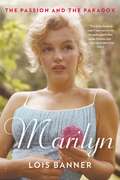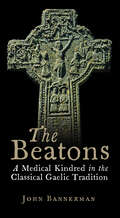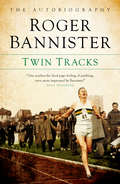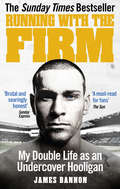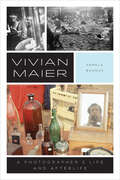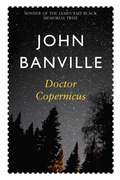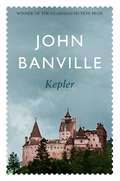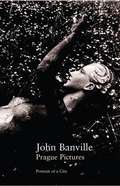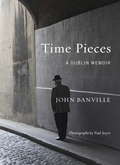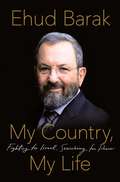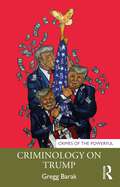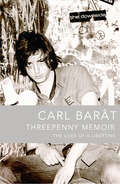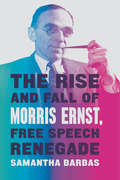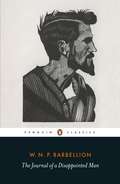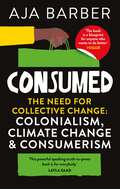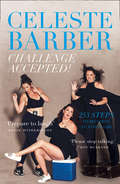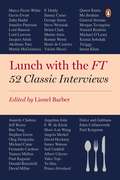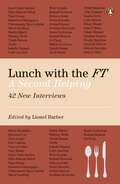- Table View
- List View
Marilyn: The Passion and the Paradox
by Lois BannerLike her art, Marilyn Monroe was rooted in paradox: She was a powerful star and a childlike waif; a joyful, irreverent party girl with a deeply spiritual side; a superb friend and a narcissist; a dumb blonde and an intellectual. No previous biographer has recognized-much less attempted to analyze-most of these aspects of her personality. Lois Banner has. With new details about Marilyn's childhood foster homes, her sexual abuse, her multiple marriages, her affairs, and her untimely death at the age of thirty-six, Marilyn is, at last, the nuanced biography Monroe fans have been waiting for.
The Beatons: A Medical Kindred in the Classical Gaelic Tradition
by John BannermanThis book traces the Clann Meic-bethad or Clan MacBeth whose members practised medicine in the classic Gaelic tradition in various parts of Scotland from the early fourteenth to the early eighteenth century. From many medieval Gaelic manuscripts known to have been in their possession, individual members of the clan and their activities are identified. Sometime in the second half of the sixteenth century the kindred began to adopt Beaton as a surname for use in non-Gaelic contexts. The medical Beatons fell naturally into two divisions: one confined mainly to the Western Isles and the other to the mainland of Scotland. This detailed study of the Beatons and their medicine describes how the position of medical doctor was inherited by the eldest son, and potential Beaton physicians were sent out to be trained by other members of the family for several years before undertaking their own practice. The book provides information on medieval medicine at the highest levels of Highland society.
Twin Tracks: The Autobiography
by Roger BannisterIt was a blustery late spring day in 1954 and a young Oxford medical student flung himself over the line in a mile race. There was an agonising pause, and then the timekeeper announced the record: three minutes, fifty-nine point four seconds. But no one heard anything after that first word - 'three'. One of the most iconic barriers of sport had been broken, and Roger Bannister had become the first man to run a mile in under four minutes. To this day, more men have conquered Mount Everest than have achieved what the slender, unassuming student managed that afternoon. Sixty years on and the letters still arrive on Roger Bannister's doormat, letters testifying to the enduring appeal of the four-minute mile and the example it set for the generation of budding athletes who were inspired to attempt the impossible. In this frank memoir, Sir Roger tells the full story of the talent and dedication that made him not just one of the most celebrated athletes of the last century but also a distinguished doctor, neurologist and one of the nation's best-loved public figures. With characteristically trenchant views on drugs in sport, the nature of modern athletics and record breaking, the extraordinary explosion in running as a leisure activity, and the Olympic legacy, this rare and brilliant autobiography gives a fascinating insight into the life of a man who has lived life to the fullest.
Running with the Firm: My Double Life As An Undercover Hooligan
by James Bannon'Of course I'm a f**king hooligan, you pr**k. I am a hooligan...there I've said it...I'm a hooligan. And, do you know why? Because that's my f**king job.'In 1995, a film called I.D., about an ambitious young copper who was sent undercover to track down the ‘generals’ of a football hooligan gang, achieved cult status for its sheer brutality and unsettling insight into the dark and often bloody side of the so-called beautiful game.The film was so shocking it was hard to believe the mindless events that took place could ever happen in the real world. Well, believe it now...Almost twenty years on, the man behind the film has explosively revealed that the script was largely a true story. That man, James Bannon, was the ambitious undercover cop. The football club was Millwall F.C. and the gang that he infiltrated was The Bushwackers, among the most brutal and fearless in English football. In Running with the Firm, Bannon shares his intense and dangerous journey into the underworld of football hooliganism where sickening levels of violence prevail over anything else. He introduces you to the hardest thugs from football’s most notorious gangs, tells all about the secret and almost comical police operations that were meant to bring them down, and, how once you’re on the inside, getting out from the mob proves to be the biggest mission of all.A disturbing but compelling read, this is the book that proves fact really is stranger than fiction.
Vivian Maier: A Photographer’s Life and Afterlife
by Pamela BannosWho was Vivian Maier? Many people know her as the reclusive Chicago nanny who wandered the city for decades, constantly snapping photographs, which were unseen until they were discovered in a seemingly abandoned storage locker. They revealed her to be an inadvertent master of twentieth-century American street photography. Not long after, the news broke that Maier had recently died and had no surviving relatives. Soon the whole world knew about her preternatural work, shooting her to stardom almost overnight. But, as Pamela Bannos reveals in this meticulous and passionate biography, this story of the nanny savant has blinded us to Maier’s true achievements, as well as her intentions. Most important, Bannos argues, Maier was not a nanny who moonlighted as a photographer; she was a photographer who supported herself as a nanny. In Vivian Maier: A Photographer’s Life and Afterlife, Bannos contrasts Maier’s life with the mythology that strangers—mostly the men who have profited from her work—have created around her absence. Bannos shows that Maier was extremely conscientious about how her work was developed, printed, and cropped, even though she also made a clear choice never to display it. She places Maier’s fierce passion for privacy alongside the recent spread of her work around the world, and she explains Maier’s careful adjustments of photographic technique, while explaining how the photographs have been misconstrued or misidentified. As well, Bannos uncovers new information about Maier’s immediate family, including her difficult brother, Karl—relatives that once had been thought not to exist. This authoritative and engrossing biography shows that the real story of Vivian Maier, a true visionary artist, is even more compelling than the myth.
Vivian Maier: A Photographer’s Life and Afterlife
by Pamela BannosWho was Vivian Maier? Many people know her as the reclusive Chicago nanny who wandered the city for decades, constantly snapping photographs, which were unseen until they were discovered in a seemingly abandoned storage locker. They revealed her to be an inadvertent master of twentieth-century American street photography. Not long after, the news broke that Maier had recently died and had no surviving relatives. Soon the whole world knew about her preternatural work, shooting her to stardom almost overnight. But, as Pamela Bannos reveals in this meticulous and passionate biography, this story of the nanny savant has blinded us to Maier’s true achievements, as well as her intentions. Most important, Bannos argues, Maier was not a nanny who moonlighted as a photographer; she was a photographer who supported herself as a nanny. In Vivian Maier: A Photographer’s Life and Afterlife, Bannos contrasts Maier’s life with the mythology that strangers—mostly the men who have profited from her work—have created around her absence. Bannos shows that Maier was extremely conscientious about how her work was developed, printed, and cropped, even though she also made a clear choice never to display it. She places Maier’s fierce passion for privacy alongside the recent spread of her work around the world, and she explains Maier’s careful adjustments of photographic technique, while explaining how the photographs have been misconstrued or misidentified. As well, Bannos uncovers new information about Maier’s immediate family, including her difficult brother, Karl—relatives that once had been thought not to exist. This authoritative and engrossing biography shows that the real story of Vivian Maier, a true visionary artist, is even more compelling than the myth.
Vivian Maier: A Photographer’s Life and Afterlife
by Pamela BannosWho was Vivian Maier? Many people know her as the reclusive Chicago nanny who wandered the city for decades, constantly snapping photographs, which were unseen until they were discovered in a seemingly abandoned storage locker. They revealed her to be an inadvertent master of twentieth-century American street photography. Not long after, the news broke that Maier had recently died and had no surviving relatives. Soon the whole world knew about her preternatural work, shooting her to stardom almost overnight. But, as Pamela Bannos reveals in this meticulous and passionate biography, this story of the nanny savant has blinded us to Maier’s true achievements, as well as her intentions. Most important, Bannos argues, Maier was not a nanny who moonlighted as a photographer; she was a photographer who supported herself as a nanny. In Vivian Maier: A Photographer’s Life and Afterlife, Bannos contrasts Maier’s life with the mythology that strangers—mostly the men who have profited from her work—have created around her absence. Bannos shows that Maier was extremely conscientious about how her work was developed, printed, and cropped, even though she also made a clear choice never to display it. She places Maier’s fierce passion for privacy alongside the recent spread of her work around the world, and she explains Maier’s careful adjustments of photographic technique, while explaining how the photographs have been misconstrued or misidentified. As well, Bannos uncovers new information about Maier’s immediate family, including her difficult brother, Karl—relatives that once had been thought not to exist. This authoritative and engrossing biography shows that the real story of Vivian Maier, a true visionary artist, is even more compelling than the myth.
Vivian Maier: A Photographer’s Life and Afterlife
by Pamela BannosWho was Vivian Maier? Many people know her as the reclusive Chicago nanny who wandered the city for decades, constantly snapping photographs, which were unseen until they were discovered in a seemingly abandoned storage locker. They revealed her to be an inadvertent master of twentieth-century American street photography. Not long after, the news broke that Maier had recently died and had no surviving relatives. Soon the whole world knew about her preternatural work, shooting her to stardom almost overnight. But, as Pamela Bannos reveals in this meticulous and passionate biography, this story of the nanny savant has blinded us to Maier’s true achievements, as well as her intentions. Most important, Bannos argues, Maier was not a nanny who moonlighted as a photographer; she was a photographer who supported herself as a nanny. In Vivian Maier: A Photographer’s Life and Afterlife, Bannos contrasts Maier’s life with the mythology that strangers—mostly the men who have profited from her work—have created around her absence. Bannos shows that Maier was extremely conscientious about how her work was developed, printed, and cropped, even though she also made a clear choice never to display it. She places Maier’s fierce passion for privacy alongside the recent spread of her work around the world, and she explains Maier’s careful adjustments of photographic technique, while explaining how the photographs have been misconstrued or misidentified. As well, Bannos uncovers new information about Maier’s immediate family, including her difficult brother, Karl—relatives that once had been thought not to exist. This authoritative and engrossing biography shows that the real story of Vivian Maier, a true visionary artist, is even more compelling than the myth.
Vivian Maier: A Photographer’s Life and Afterlife
by Pamela BannosWho was Vivian Maier? Many people know her as the reclusive Chicago nanny who wandered the city for decades, constantly snapping photographs, which were unseen until they were discovered in a seemingly abandoned storage locker. They revealed her to be an inadvertent master of twentieth-century American street photography. Not long after, the news broke that Maier had recently died and had no surviving relatives. Soon the whole world knew about her preternatural work, shooting her to stardom almost overnight. But, as Pamela Bannos reveals in this meticulous and passionate biography, this story of the nanny savant has blinded us to Maier’s true achievements, as well as her intentions. Most important, Bannos argues, Maier was not a nanny who moonlighted as a photographer; she was a photographer who supported herself as a nanny. In Vivian Maier: A Photographer’s Life and Afterlife, Bannos contrasts Maier’s life with the mythology that strangers—mostly the men who have profited from her work—have created around her absence. Bannos shows that Maier was extremely conscientious about how her work was developed, printed, and cropped, even though she also made a clear choice never to display it. She places Maier’s fierce passion for privacy alongside the recent spread of her work around the world, and she explains Maier’s careful adjustments of photographic technique, while explaining how the photographs have been misconstrued or misidentified. As well, Bannos uncovers new information about Maier’s immediate family, including her difficult brother, Karl—relatives that once had been thought not to exist. This authoritative and engrossing biography shows that the real story of Vivian Maier, a true visionary artist, is even more compelling than the myth.
Vivian Maier: A Photographer’s Life and Afterlife
by Pamela BannosWho was Vivian Maier? Many people know her as the reclusive Chicago nanny who wandered the city for decades, constantly snapping photographs, which were unseen until they were discovered in a seemingly abandoned storage locker. They revealed her to be an inadvertent master of twentieth-century American street photography. Not long after, the news broke that Maier had recently died and had no surviving relatives. Soon the whole world knew about her preternatural work, shooting her to stardom almost overnight. But, as Pamela Bannos reveals in this meticulous and passionate biography, this story of the nanny savant has blinded us to Maier’s true achievements, as well as her intentions. Most important, Bannos argues, Maier was not a nanny who moonlighted as a photographer; she was a photographer who supported herself as a nanny. In Vivian Maier: A Photographer’s Life and Afterlife, Bannos contrasts Maier’s life with the mythology that strangers—mostly the men who have profited from her work—have created around her absence. Bannos shows that Maier was extremely conscientious about how her work was developed, printed, and cropped, even though she also made a clear choice never to display it. She places Maier’s fierce passion for privacy alongside the recent spread of her work around the world, and she explains Maier’s careful adjustments of photographic technique, while explaining how the photographs have been misconstrued or misidentified. As well, Bannos uncovers new information about Maier’s immediate family, including her difficult brother, Karl—relatives that once had been thought not to exist. This authoritative and engrossing biography shows that the real story of Vivian Maier, a true visionary artist, is even more compelling than the myth.
Doctor Copernicus: A Novel (Revolutions Trilogy #1)
by John Banville‘Banville is superb . . . there are not many historical novels of which it can be said that they illuminate both the time that forms their subject matter and the time in which they are read: Doctor Copernicus is among the very best of them’ The EconomistThe first in John Banville Revolutions Trilogy and winner of the James Tait Black Memorial Prize, Doctor Copernicus is a rich historical novel that explores the life of one of history's greatest scientists. The work of Nicholas Koppernigk, better known as Copernicus, shattered the medieval view of the universe and led to the formulation of the image of the solar system we know today. Here his life is powerfully evoked in a novel that offers a vivid portrait of a man of painful reticence, haunted by a malevolent brother and baffled by the conspiracies that rage around him and his ideas while he searches for the secret of life.
Kepler: A Novel (Revolutions Trilogy #2)
by John Banville‘Superbly illuminates the man, the time, and the everlasting quest for knowledge’ Observer Johannes Kepler, born in 1571 in south Germany, was one of the world’s greatest mathematicians and astronomers. The novel Kepler, by John Banville, brilliantly recreates his life and his incredible drive to chart the orbits of the planets and the geometry of the universe while being driven from exile to exile by religious and domestic strife. At the same time it illuminates the harsh realities of the Renaissance world; rich in imaginative daring but rooted in poverty, squalor and the tyrannical power of emperors.
Prague Pictures: Portraits of a City (Writer And The City Ser.)
by John BanvilleFrom one of the foremost chroniclers of the modern European experience, a panoramic view of a city that has seduced and bewitched visitors for centuries. The fourth book in Bloomsbury's Writer and the City series. Prague is the magic capital of Europe. Since the days of Emperor Rudolf II, "devotee of the stars and cultivator of the spagyric art", who in the late 1500s summoned alchemists and magicians from all over the world to his castle on Hradèany hill, it has been a place of mystery and intrigue. Wars, revolutions, floods, the imposition of Soviet communism, and even the depredations of the tourist boom after the Velvet Revolution of 1989 could not destroy the unique atmosphere of this beautiful, proud, and melancholy city on the Vltava. John Banville traces Prague's often tragic history and portrays the people who made it: the emperors and princes, geniuses and charlatans, heroes and scoundrels. He also paints a portrait of the Prague of today, reveling in its newfound freedoms, eager to join the European Community and at the same time suspicious of what many Praguers see as yet another totalitarian takeover. He writes of his first visit to the city, in the depths of the Cold War, and of subsequent trips there, of the people he met, the friends he made, the places he came to know.
Time Pieces: A Dublin Memoir
by John Banville Paul Joyce'If you're interested in Dublin, or if you're interested in the novelist John Banville, or if you're interested in radiantly superb sentences about whatever - I'm all three - then Time Pieces: A Dublin Memoir is a book you'll not be able to put down' The Guardian'A trove of arresting imagery, from the lushly poetic to the luridly absurd ... utterly delightful' Irish Times'Delicious ... Banville's soarings, like a hawk's, are both wild and comprehensive, taking in everything and imagining more' New York TimesFor the young John Banville, Dublin was a place of enchantment and yearning. Each year, on his birthday - the 8th of December, Feast of the Immaculate Conception - he and his mother would journey by train to the capital city, passing frosted pink fields at dawn, to arrive at Westland Row and the beginning of a day's adventures that included much-anticipated trips to Clery's and the Palm Beach ice-cream parlour. The aspiring writer first came to live in the city when he was eighteen. In a once grand but now dilapidated flat in Upper Mount Street, he wrote and dreamed and hoped. It was a cold time, for society and for the individual - one the writer would later explore through the famed Benjamin Black protagonist Quirke - but underneath the seeming permafrost a thaw was setting in, and Ireland was beginning to change.Alternating between vignettes of Banville's own past, and present-day historical explorations of the city, Time Pieces is a vivid evocation of childhood and memory - that 'bright abyss' in which 'time's alchemy works' - and a tender and powerful ode to a formative time and place for the artist as a young man. Accompanied by images of the city by photographer Paul Joyce.
My Country, My Life: Fighting for Israel, Searching for Peace
by Ehud BarakIn the summer of 2000, the most decorated soldier in Israel's history – Ehud Barak – set himself a challenge as daunting as any he had faced on the battlefield: to secure a final peace with the Palestinians. He would propose two states for two peoples, with a shared capital in Jerusalem. He knew the risks of failure. But he also knew the risks of not trying: letting slip perhaps the last chance for a generation to secure genuine peace. It was a moment of truth. It was one of many in a life intertwined, from the start, with that of Israel. Born on a kibbutz, Barak became commander of Israel's elite special forces, then army Chief of Staff, and ultimately, Prime Minister. My Country, My Life tells the unvarnished story of his - and his country's - first seven decades; of its major successes, but also its setbacks and misjudgments. He offers candid assessments of his fellow Israeli politicians, of the American administrations with which he worked, and of himself. Drawing on his experiences as a military and political leader, he sounds a powerful warning: Israel is at a crossroads, threatened by events beyond its borders and by divisions within. The two-state solution is more urgent than ever, not just for the Palestinians, but for the existential interests of Israel itself. Only by rediscovering the twin pillars on which it was built – military strength and moral purpose – can Israel thrive.
Criminology on Trump (Crimes of the Powerful)
by Gregg BarakCriminology on Trump is a criminological investigation of the world’s most successful outlaw, Donald J. Trump. Over the course of five decades, Donald Trump has been accused of sexual assault, tax evasion, money laundering, non-payment of employees, and the defrauding of tenants, customers, contractors, investors, bankers, and charities. Yet, he has continued to amass wealth and power. In this book, criminologist and social historian Gregg Barak asks why and how?This book examines how the United States precariously maintains stability through conflict in which groups with competing interests and opposing visions struggle for power, negotiate rule breaking, and establish criminal justice. While primarily focused on Trump’s developing character over three quarters of a century, it is also an inquiry into the changing cultural character and social structure of American society. It explores the ways in which both crime and crime control are socially constructed in relation to a changing political economy.An accessible and compelling read, this book is essential for all those who seek a criminological understanding of Donald Trump’s rise to power.
Criminology on Trump (Crimes of the Powerful)
by Gregg BarakCriminology on Trump is a criminological investigation of the world’s most successful outlaw, Donald J. Trump. Over the course of five decades, Donald Trump has been accused of sexual assault, tax evasion, money laundering, non-payment of employees, and the defrauding of tenants, customers, contractors, investors, bankers, and charities. Yet, he has continued to amass wealth and power. In this book, criminologist and social historian Gregg Barak asks why and how?This book examines how the United States precariously maintains stability through conflict in which groups with competing interests and opposing visions struggle for power, negotiate rule breaking, and establish criminal justice. While primarily focused on Trump’s developing character over three quarters of a century, it is also an inquiry into the changing cultural character and social structure of American society. It explores the ways in which both crime and crime control are socially constructed in relation to a changing political economy.An accessible and compelling read, this book is essential for all those who seek a criminological understanding of Donald Trump’s rise to power.
Threepenny Memoir: The Lives Of A Libertine
by Carl BaratThe extraordinary life and times of Carl Barat, Libertine.
The Rise and Fall of Morris Ernst, Free Speech Renegade
by Samantha BarbasA long-overdue biography of the legendary civil liberties lawyer—a vital and contrary figure who both defended Ulysses and fawned over J. Edgar Hoover. In the 1930s and ’40s, Morris Ernst was one of America’s best-known liberal lawyers. The ACLU’s general counsel for decades, Ernst was renowned for his audacious fights against artistic censorship. He successfully defended Ulysses against obscenity charges, litigated groundbreaking reproductive rights cases, and supported the widespread expansion of protections for sexual expression, union organizing, and public speech. Yet Ernst was also a man of stark contradictions, waging a personal battle against Communism, defending an autocrat, and aligning himself with J. Edgar Hoover’s inflammatory crusades. Arriving at a moment when issues of privacy, artistic freedom, and personal expression are freshly relevant, The Rise and Fall of Morris Ernst, Free Speech Renegade brings this singularly complex figure into a timely new light. As Samantha Barbas’s eloquent and compelling biography makes ironically clear, Ernst both transformed free speech in America and inflicted damage to the cause of civil liberties. Drawing on Ernst’s voluminous cache of publications and papers, Barbas follows the life of this singular idealist from his pugnacious early career to his legal triumphs of the 1930s and ’40s and his later idiosyncratic zealotry. As she shows, today’s challenges to free speech and the exercise of political power make Morris Ernst’s battles as pertinent as ever.
The Rise and Fall of Morris Ernst, Free Speech Renegade
by Samantha BarbasA long-overdue biography of the legendary civil liberties lawyer—a vital and contrary figure who both defended Ulysses and fawned over J. Edgar Hoover. In the 1930s and ’40s, Morris Ernst was one of America’s best-known liberal lawyers. The ACLU’s general counsel for decades, Ernst was renowned for his audacious fights against artistic censorship. He successfully defended Ulysses against obscenity charges, litigated groundbreaking reproductive rights cases, and supported the widespread expansion of protections for sexual expression, union organizing, and public speech. Yet Ernst was also a man of stark contradictions, waging a personal battle against Communism, defending an autocrat, and aligning himself with J. Edgar Hoover’s inflammatory crusades. Arriving at a moment when issues of privacy, artistic freedom, and personal expression are freshly relevant, The Rise and Fall of Morris Ernst, Free Speech Renegade brings this singularly complex figure into a timely new light. As Samantha Barbas’s eloquent and compelling biography makes ironically clear, Ernst both transformed free speech in America and inflicted damage to the cause of civil liberties. Drawing on Ernst’s voluminous cache of publications and papers, Barbas follows the life of this singular idealist from his pugnacious early career to his legal triumphs of the 1930s and ’40s and his later idiosyncratic zealotry. As she shows, today’s challenges to free speech and the exercise of political power make Morris Ernst’s battles as pertinent as ever.
The Journal of a Disappointed Man: The Journal Of A Disappointed Man; A Last Diary; Enjoying Life And Other Literary Remains
by W. N. BarbellionThe young naturalist W. N. P. Barbellion described this remarkably candid record of living with multiple sclerosis as 'a study in the nude'. It begins as an ambitious teenager's notes on the natural world, and then, following his diagnosis at the age of twenty-six, transforms into a deeply moving account of battling the disease. His prose is full of humour and fierce intelligence, and combines a passion for life with clear-sighted reflections on the nature of death. Barbellion selected and edited this manuscript himself in 1917, adding a fictional editor's note announcing his own demise. This Penguin Classics edition includes 'The Last Diary', which covers the period between submission of the manuscript and Barbellion's actual death in 1919.
Consumed: The need for collective change; colonialism, climate change & consumerism
by Aja Barber'Consumed takes us through the hideously complex topic of fashion and sustainability, from its knotty colonial roots to what everyday people can do to uproot those systems, today.' - Yassmin Abdel-Magied 'SUCH integrity. Aja is no bullsh*t.' - Florence Given Aja Barber wants change. In the 'learning' first half of the book, she will expose you to the endemic injustices in our consumer industries and the uncomfortable history of the textile industry; one which brokered slavery, racism and today's wealth inequality. And how these oppressive systems have bled into the fashion industry and its lack of diversity and equality. She will also reveal how we spend our money and whose pockets it goes into and whose it doesn't (clue: the people who do the actual work) and will tell her story of how she came to learn the truth.In the second 'unlearning' half of the book, she will help you to understand the uncomfortable truth behind why you consume the way you do. She asks you to confront the sense of lack you have, the feeling that you are never quite enough and the reasons why you fill the aching void with consumption rather than compassion. And she makes you challenge this power disparity, and take back ownership of it. The less you buy into the consumer culture the more power you have.CONSUMED will teach you how to be a citizen not a consumer. 'An absolute must-read for any person who wears clothes.' - Orsola de Castro 'A hugely compelling exploration of a culture of exploitation and how, together, we can end it.' - Gina Martin 'Barber's isn't just a voice we should listen to - it is a voice we MUST listen to.' - Clementine Ford 'If you buy one book about sustainable fashion, make it this one. Consumed is an urgent call to action to demand a fashion system that is actually fair for both people and planet, not just Big Fashion billionaires. I adore Aja and I love this brilliant book.' - Venetia La Manna
Challenge Accepted!: 253 Steps To Becoming An Anti-it Girl
by Celeste Barber‘Prepare to laugh’ – Reese Witherspoon 253 steps to becoming an anti-it girl.
Lunch with the FT: 52 Classic Interviews
by Lionel BarberFrom the very first mouthful, 'Lunch with the FT' was destined to become a permanent fixture in the Financial Times.One thousand lunches later, the FT's weekly interview has become an institution. From film stars to politicians, tycoons to writers, dissidents to lifestyle gurus, the list reads like an international Who's Who of our times. Lunch with the FT is a selection of the best: 52 classic interviews conducted in the unforgiving proximity of a restaurant table. From Angela Merkel to Sean 'P. Diddy' Combs, Martin Amis to one of the Arab world's most notorious sons, this book brings you right to the table to decide what you think of or world's most powerful players.
Lunch with the FT: A Second Helping
by Lionel BarberLunch with the FT has been a permanent fixture in the Financial Times for almost 30 years, featuring presidents, film stars, musical icons and business leaders from around the world.The column is now a well-established institution, which has reinvigorated the art of conversation in the convivial, intimate environment of a long and boozy lunch.This new and updated edition includes lunches with:Elon MuskDonald TrumpHilary MantelRichard BransonZadie SmithNigel FarageRussell BrandDavid GuettaYanis VaroufakisJean-Claude JunckerGwyneth PaltrowRebecca SolnitJordan PetersonChimamanda Ngozi AdichieAnd more...
